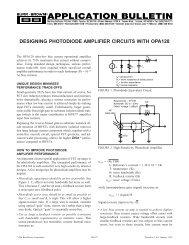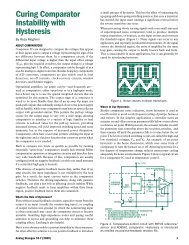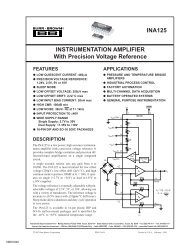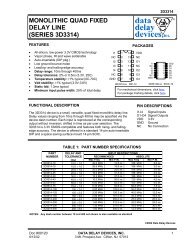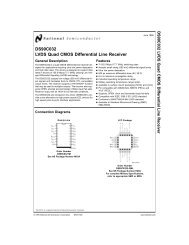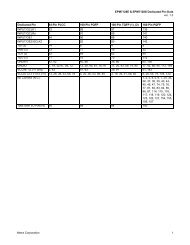SRAM System Design Guidelines
SRAM System Design Guidelines
SRAM System Design Guidelines
You also want an ePaper? Increase the reach of your titles
YUMPU automatically turns print PDFs into web optimized ePapers that Google loves.
<strong>SRAM</strong> <strong>System</strong> <strong>Design</strong> <strong>Guidelines</strong>The average current supplied is equal to the total chargesupplied divided by the length of time T:⎛C----⎞ ( Y–X)VCharge ⎝in·⎠I = ---------------- = ----------------------------------------TL( Y–X)⎛----⎞⎛----C⎞⎝in·⎠⎝in·⎠. Eq. 12This gives us the current flow required to sustain a propagatingstep edge of V volts. Therefore, the characteristicimpedance of an ideal line can be found through simplificationZ o =V--- = ---LEq. 13I Cwhere L and C are given in per-unit lengths.As this equation shows, the value of characteristic impedancefor ideal lines is real-valued, constant, and dependent only onthe inductance and capacitance of the line-per-unit length.This allows us to model a transmission line as a simpleresistor.The characteristic impedance equation given above for anideal line does not depend on the frequency of the system.This is not the case for a lossy line, however. The generalformula for characteristic impedance is given asV R+jωLZ o = --- = ----------------- . Eq. 14I jωCThis is the impedance if a finite value of resistance exists.Note that Z o is actually a function of frequency. However,since digital signals operate at very high frequency alongPCB traces that have very low resistance, it is simpler to usethe form given in Equation 10.Termination StrategiesThe end goal of all termination strategies is to remove voltagereflection on the line by cancelling out the two voltagereflection coefficients. There are two general strategies fordoing this:1. match the load impedance to the line’s characteristic impedance.2. match the source impedance to the line’s characteristicsimpedance.Under one of these conditions, the load or source reflectioncoefficient will be made to equal zero and thus there will beno reflection. If the load is matched, there will be no reflectionback to the source, and if the source is matched, thisreflection will not bounce back again toward the load.Matching the load is slightly preferred, since eliminating thefirst reflection will reduce EMI and electrical noise, and also itseems logical to try and eliminate any reflections as soon asone might occur.approved kkv 10/__/02© Cypress Semiconductor Corporation, 2002. The information contained herein is subject to change without notice. Cypress Semiconductor Corporation assumes no responsibility for the useof any circuitry other than circuitry embodied in a Cypress Semiconductor product. Nor does it convey or imply any license under patent or other rights. Cypress Semiconductor does not authorizeits products for use as critical components in life-support systems where a malfunction or failure may reasonably be expected to result in significant injury to the user. The inclusion of CypressSemiconductor products in life-support systems application implies that the manufacturer assumes all risk of such use and in doing so indemnifies Cypress Semiconductor against all charges.



